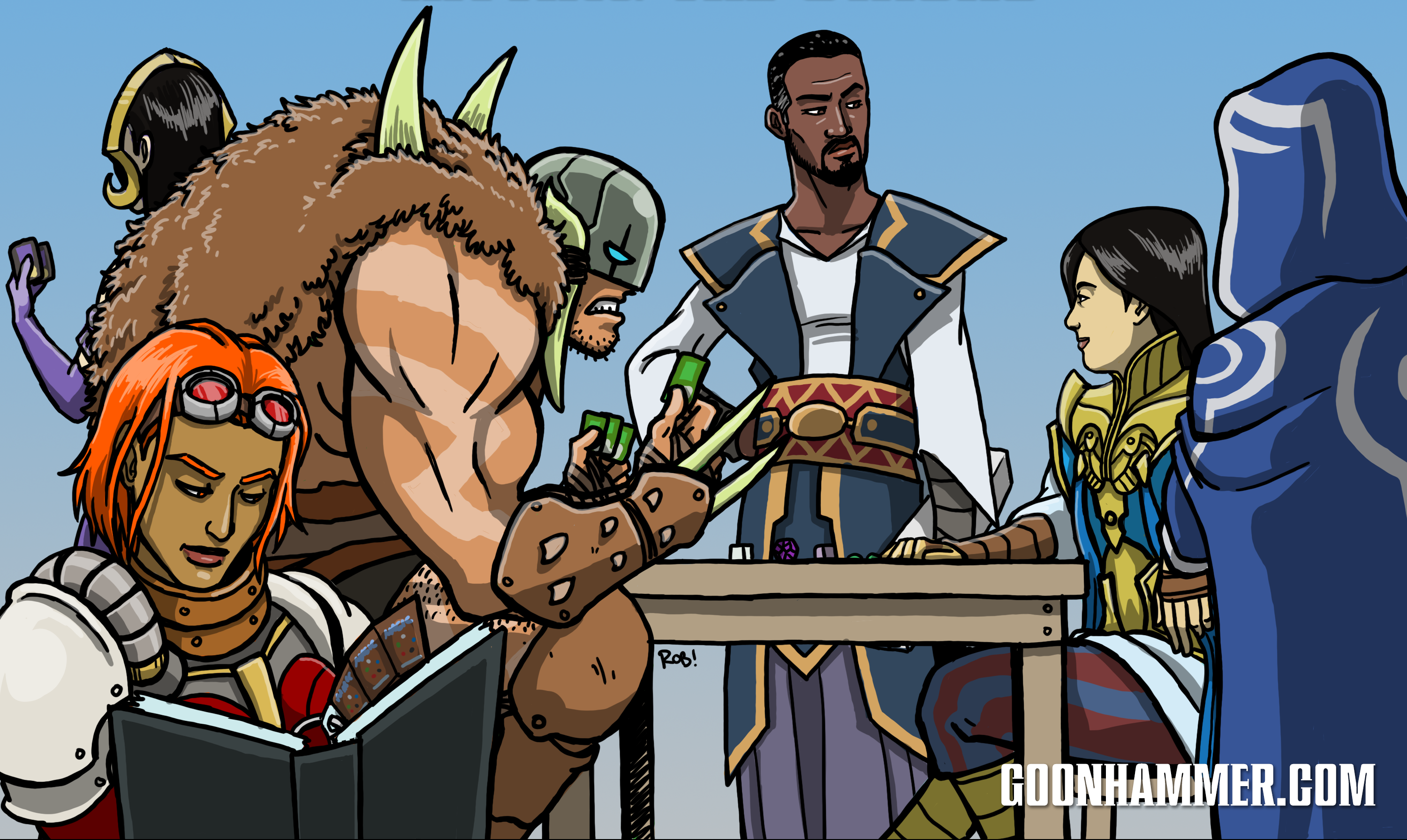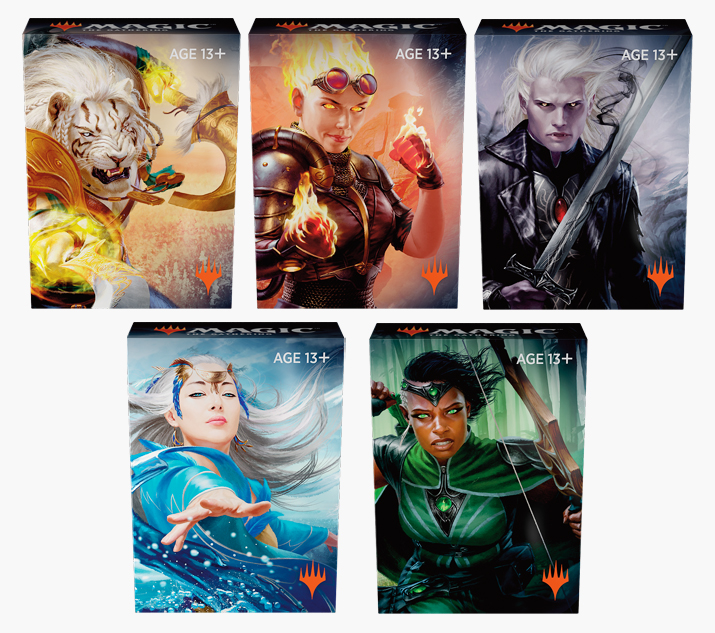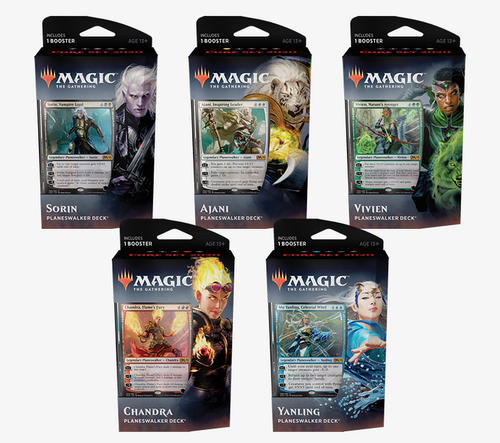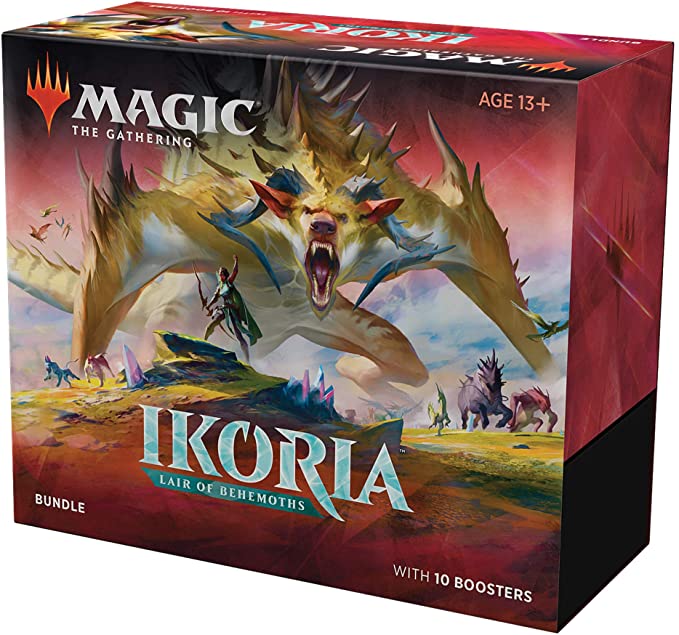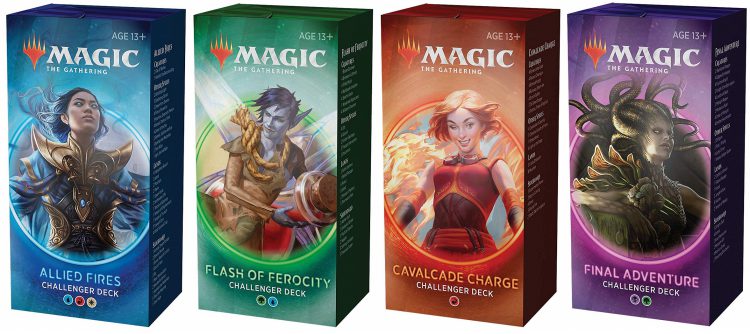So you’ve played a few games and enjoyed them, and decided that you want to take the plunge with Magic: The Gathering. Good choice! Magic is one of our favorite games, with dozens of game variants, tons of wonderful complexity, and a massive player base with support in almost any game store you’ll come across. Getting started with Magic: The Gathering can be a daunting prospect. It’s a game with almost thirty years of history, a thriving economy and secondary market, and a massive competitive scene. Figuring out where and how you want to jump in can be tricky, but we’ve got you covered.
In this article, we’ll be covering the paper axis of Magic. We’ll cover Arena in another article, as that’s a completely different process, and in some ways, a totally different game.
Before we dive in, know that there’s no correct way to get started in Magic. It’s a social game and most people get into the game because they know someone that plays already. There’s many different variants of playing Magic, but some are easier on new players than others. The crowd you might play with will pull you into whatever their preferred playstyle is. Sometimes that experience works out and sometimes it doesn’t. We’ll cover a few different ways to go but for most people, our general recommendation is to play in the plainest, most basic way possible. No formats, no variants, no house rules. Just sixty Magic cards in one or two colors made up with whatever you can find.
Kitchen Table and “Board Game” Magic
This is what we recommend as your first step–buying or building a few decks, shuffling them, and playing games of Magic with friends. Depending on your–and their–preferences, you may each bring your own decks to play, building with the cards you each have at home, or one person may own several decks that they’ve built and lend out to other players to play with. Both avenues are good, and if you’ve got new players, having a few decks around that can play well against each other is a good way to jump in and start playing quickly.
How to Acquire the Cards You Need
If you want to play Magic, you’re going to need cards, and that means building a collection. This can be a fun and rewarding process, and there are many ways to add to a collection, some more expensive and time-consuming than others.
I Need Lands!
One of the first major hurdles of getting into Magic is acquiring enough basic lands to build a deck with. Booster packs typically contain one basic land in every pack, but if you settle on a color or pair of colors, it will take a lot of packs in order to get a good starting count of lands. Wizards of the Coast provides several introductory products that come with plenty of basic lands for a new player to whet their palate with.
Some Recommended Entry Points
There are numerous ways to jump in and start building your own collection of Magic cards to play with. Here are some of the simplest:
Just ask – Free!
You likely know someone that plays Magic if you’re trying to get into it. It’s inevitable for players to have a stack of cards that are clutter because they’ve been accumulating cards from their drafts or have a booster pack-buying habit. Ask another Magic player you know if they have some cards they don’t mind giving away or letting you borrow to learn with. A game store might even have cards to give away or sell for cheap for new players that they hope become returning customers.
Welcome Decks – Free!
Welcome decks are ready-made decks of thirty cards that are provided for free from local game stores. They are a single color and come with thirteen basic lands that match the color of that deck. The decks also help establish the core concepts of their color’s identity. They are introductory products for bringing in new players. You can get a feel for playing the game this way without spending a dime and the cards are yours to keep. Some game stores will provide customers with more than one welcome deck upon asking so that a new player can have their first sixty-card deck (the minimum deck size for Constructed Magic). You can stack two welcome decks on the same color or get two of different colors. There is no recommended combination of colors, so don’t worry about picking a bad combo. Just get some cards and play.
Each of these packs contains two thirty-card decks, so having one will give you either one deck to play with or a pair to try with a friend. As of June, Wizards ended the Welcome Decks series, replacing it with Welcome Boosters and Arena Starter kits. The Arena starter kit is a two-player kit with two decks designed to teach new players the game and get them excited about it. After playing with the decks in a store, players could be rewarded with a Welcome booster. Welcome boosters are a collection of 10 carefully selected cards that represent a variety of different Magic tastes and formats and comes with a code for unlocking the decks in Arena. These are make comparable replacements for the Welcome Decks, but will most likely cost you a few bucks. If you’re starting you may want to see if your local game store still has a welcome deck or two floating around, since those can sit around for a while. Otherwise, adding a welcome booster to a Planeswalker Deck or a Deckbuilder’s toolkit can also work. Speaking of which…
Planeswalker Decks – $14
Planeswalker decks are preconstructed sixty-card decks that showcase a planeswalker character and a deck in their color(s). The planeswalker in these decks is unique to this deck. Also included in planeswalker decks is two booster packs in the same expansion that the deck was released with. These decks are made with making the marquis card in the deck its capstone and building toward it. There are always two different planeswalker decks released with each expansion and they are designed to be played against each other. Planeswalker decks can be found at any game store selling Magic product and at big box stores like Walmart and Target. Your local game store might also cut you a deal if you buy the other deck too.
Deck Builder’s Toolkit – $18
The deck builder’s toolkit is the gateway for new players to start constructing their own decks. It comes with 125 cards across all five colors that you can use to improve your planeswalker deck or welcome deck, 100 basic lands (twenty of each type), and four booster packs from expansion sets released in the last year. The box is reusable and designed to store your cards in. It’s an instant starter collection and is contained in a box that you can use to store your new cards. This product is the best thing you can spend your money on if it’s your first Magic purchase. Deck builder’s toolkits can also be found at game stores and big box stores.
Set Bundles – $40
Formerly called “fat packs,” set bundles are a box of ten booster packs, forty basic lands, tokens, a twenty-sided spindown die, and other accessories. Unlike the deck builder’s toolkit, all of the cards are from only one set. The box that the bundle comes in is reusable and can store about 400 cards. We do not recommend buying a set bundle as your first product, but it is a good injection of cards from the newest set. Set bundles retail for about $40 and are found in game stores and big box stores.
Challenger Decks – $20, but usually varies
Challenger decks are sixty-card decks that come with a fifteen-card sideboard. These decks are made to help players get a foothold into tournament Magic and are excellent things to have for your first Friday Night Magic. The cards selected for challenger decks are chosen with tournament play in mind. None of them will contain all of the pieces for a top tier deck, but you should expect to get a foundation of a tournament-caliber deck for Standard. These decks can be found at your local game store and at big box retailers. The secondhand value of the singles in challenger decks is usually higher than the retail price of the deck, which makes them an excellent deal even for established players. Challenger decks with highly sought after cards can sometimes be difficult to find because they’ve been bought out and are usually priced higher because of their desirability.
Things to Avoid
Magic is a deep, complicated game, and there are a few things you should avoid as a new player–some until you’re familiar with the dynamics of the game’s economy and the type and level of play you want, and some just forever. Here are a few things to avoid:
Don’t buy booster packs
Booster packs have fifteen random cards—ten commons, three uncommons, one rare or mythic rare, and a basic land. Sometimes they contain a premium foil card and the foil replaces a common. Buying a handful of packs will probably accompany your first sealed Magic product, and that’s perfectly fine. Even veteran players still buy booster packs for the sake of opening them every once in a while. Buying only booster packs will make getting started in Magic frustrating because it will make acquiring basic lands difficult. Because the cards inside are totally random, it’s hard to get specific cards or even cards in the colors you’re starting out with. It’s also an inefficient use of your money. We’ll go into more of the specifics of why booster packs are a bad purchase in a later article, but it’s understandable for new players to just buy a bunch over time to grow their collection, just don’t get crazy.
Commander preconstructed decks
Commander is a variant of Magic that plays with 100-card decks and only one copy of a card is allowed per deck except for basic lands, with a legendary creature that is your deck’s commander. It’s become the most popular casual format and is likely the most played variant of Magic. It’s also a bit overwhelming for a new player because it’s a lot of cards from all over Magic’s history as well as new cards specific to that set. They’re good products if you are interested in getting started in Commander, but Commander is a complicated variant of an already complicated game–best to avoid these when you’re starting out.
Chaos draft boxes, products in plastic cases at big box stores
These products are the inventions of distributors that are trying to find a way to sell unmoved products. They’re typically things like booster packs from expansions that weren’t very popular or other supplemental products that didn’t sell. The booster packs are often old enough to have rotated out of Standard or are about to and the cards you can’t see are scraps from old duel decks that no one bought. They’re priced way too high for what’s probably junk inside. Don’t buy these.
Tournament Magic
Tournament Magic is great and is what keeps so many of us interested in the game. It can also seem daunting for a new player especially if all they have is the cards in their welcome decks and from a handful of booster packs they bought, because they’re probably going to get rolled over and have a bad experience or not fully understand how to booster draft. Play Magic casually for as long as you feel you need to get comfortable with the rules before you start getting into tournaments. Once you know the structure of the game, going to a Friday Night Magic will be a smoother experience. When you are ready for tournament Magic, we’ll have a primer on how to get started.
Tips for the New Player
While going into the specifics of how to play well is beyond the scope of this introductory article,
Consider testing before you buy new cards
As you go further down the rabbit hole that is building new decks, you’ll likely have many ideas for new decks, ranging from “I could add this creature to my deck” to “I have an insane but genius idea to build around this card no one loves.” But buying the cards for every new deck idea can become expensive quickly. If you’re playing with friends or just want to test things out, consider testing with proxies before you buy new cards–write down the card name on an extra land or card you don’t care about and see how you like it. Then refine your idea and buy the cards you need to make it a reality.
Read the rules
Most players learn how to play from a friend. There’s nothing wrong with that, it’s the easiest way to learn! But that also means that most players don’t learn the full rules of the game, and may pick up bad habits. Once you’ve played a bit, consider sitting down and reading the basic rules of the game so you understand how to play spells and how priority and the stack works. Doing this goes a long way, especially if you want to play competitively at some point.
Some general deck building guidelines for the beginner
A lot of articles have been written about building good decks, how much land to use, and how to combine colors. We’re not going to go into a ton of detail on those here, but when you start building your first decks, building with the following guidelines should help make sure your creations are playable out of the gate. These are also some guidelines we’d recommend if you’re building some beginner/intro decks as well.
- Focus on keeping to the sixty-card minimum (with no more than four copies of any card that isn’t a basic land), with thirty-seven spells and twenty-three lands. As you get more comfortable with the game and deckbuilding, you can play around more with these numbers, but this is a pretty good guideline for a spell-to-land mix.
- Try to make sure that the majority of spells in your deck cost between two and four mana, and unless you’re building a control deck, try to make sure you have at least twelve creatures in there so your deck will have attackers. Limit the number of spells that you have costing 5+ mana.
- Try and stick to one or two colors, especially if all of your lands are basic lands.
So How Did You Start Out?
Sean
The Pokémon Trading Card Game was my first card game and I picked that up in 1999 when I was twelve-years-old. I played in weekly tournaments and in Pokémon Leagues starting in 2000 and developed a taste for playing competitively because I learned that my idea of fun was winning. I hung out in the Pokémon TCG board on GameFAQs a lot starting in 2000 when I was thirteen and read Pojo whenever I could manage to get a copy. I moved on to Score’s Dragon Ball Z Collectible Card Game in 2001 when I started high school until 2005. I did post and trade cards with people on the DBZ Fanatics forum, but I was never able to attend a major tournament (such is life when you live in Wyoming). When I got into college, the crowd I hung out with played Magic and I decided to try. I bought the white and blue theme decks when Ninth Edition was new, but the people I played with were awful teachers of the game. They played with whatever it was they had on hand and the mixture of cards from the game’s then twelve-year history completely overwhelmed me and I gave up.
I tried again in summer of 2008. I bought the blue and green theme decks in Tenth Edition, a couple of Tenth Edition packs, and the Morningtide fat pack. I watched a video on Wizards’ YouTube channel about how to play the game, ran both theme decks against each other by myself, and built up a collection with competitive play in mind. When I moved to Laramie to resume my undergrad, I made do with what I had in Standard and Legacy and built up what I could into what was affordable in 2009 and later. I’ve had the opportunity to attend a handful of bigger tournaments, but my play has mostly been at local tournaments. It’s hard to play big-tournament Magic in the Rocky Mountain west, but it’s been my drive in Magic.
Robert
A friend taught me how to play a looooong time ago and after that I bought a lot of boosters, trading for the cards I could. That’s pretty much the worst possible way to do things, especially now that you can easily buy cards in bulk and get specific cards by ordering from online retailers. These days if I had to start over I’d likely get a Game Night pack or a pair of Planeswalker decks to play with a friend and give those a few games. If you’re looking to build a collection long-term, it’s almost always going to be better to buy individual cards that you need than trying to get something randomly though if you’re into booster draft that can be a fun way to expand your collection in unintentional ways. What I’ll usually do these days is buy a box of boosters when a new set comes out and draft it with friends. The value there is less about the actual cards and the fun experience of playing together, though.
Taking the Next Step
Once you’ve gotten comfortable with the game and have a small collection for kitchen table play, you might want to expand to events and broader play environments. In these next sections, we’re going to cover the most popular ways to play paper Magic, with some thoughts on how you can get started with each.
Arena and Magic Online
Arena and Magic Online (MODO) are the two ways to play Magic online. They’ve each got their advantages and disadvantages, but they’re also entirely separate from paper Magic. We’ll be covering how to get started in those in future articles, starting with Arena tomorrow.
Commander
Commander is one of Magic’s most popular formats – players build 100-card decks that include a single legendary creature to act as their Commander, which can be cast during the game. The Commander format is a whole different beast to standard 60-card constructed Magic, with its own quirks and nuances. We’ll be covering how to get started with Commander later this week.
Competitive Play
Few tabletop games can match the competitive scene for Magic and if you play regularly, you may want to consider going to competitive events, which can range from casual Friday Night Magic and booster drafts to the steady grind of serious tournaments on the Pro Tour circuit. Like Commander, this is also a deep topic with tons to talk about, so we’ll talk about getting started with Competitive play in a future article.
Moving On
That wraps up our look at how to dip your toe into the exciting world of Magic: the Gathering. We’ll be covering more ways to play later this week and next week we’ll start looking at more in-depth content for the game. In the meantime, if you have any questions or feedback, or requests for future articles, drop us a note in the comments below or email us at contact@goonhammer.com.
